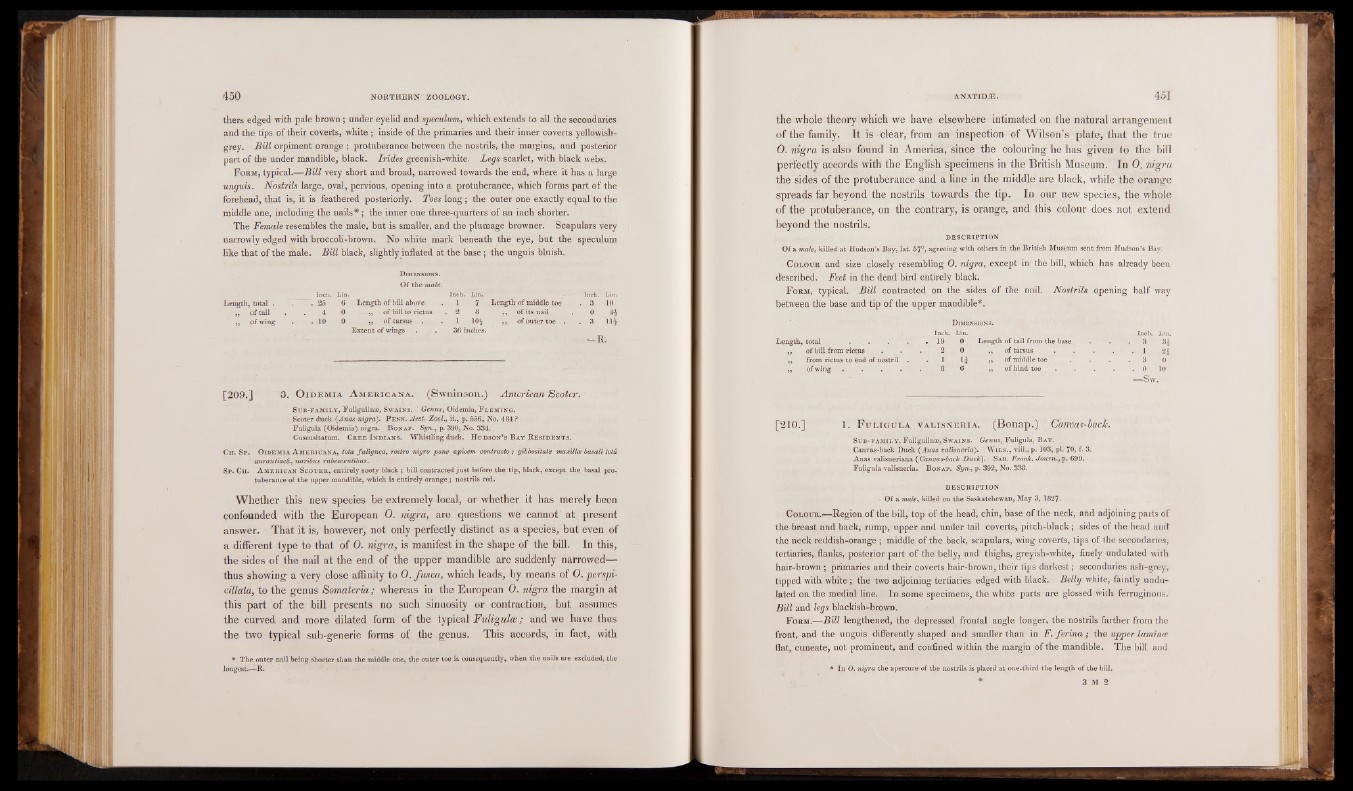
thers edged with pale brown; under eyelid and speculum, which extends to all the secondaries
and the tips of their coverts, white ; inside of the primaries and their inner coverts yellowish-
grey. Bill orpiment orange ; protuberance between the nostrils, the margins, and posterior
part of the under mandible, black. Irides greenish-white. Legs scarlet, with black webs.
Form, typical.—Bill very short and broad, narrowed towards the end, where it has a large
unguis. Nostrils large, oval, pervious, opening into a protuberance, which forms part of the
forehead, that is, it is feathered posteriorly. Toes long; the outer one exactly equal to the
middle one, including the nails*; the inner one three-quarters of an inch shorter.
The Female resembles the male, but is smaller, and the plumage browner. Scapulars very
narrowly edged with broccoli-brown. No white mark beneath the eye, but the speculum
like that of the male. Bill black, slightly inflated at the base; the unguis bluish.
Dimensions.
Of the male.
Inèh'. Lin. Ifich. Lib. Length, total * . . 25 6 Length of bill above . 1 7 Length of middle toe
,, of tail . . 4 0 ___of bill to rictus » 2 8 , , ' of its nail
' ' jj of wing . .1 0 9 ,, of tarsus . . 1 10| ,, of outer toe
Extent of wings . . 36 inches.
[209.] 3. O id e m ia A m e r ic a n a . (Swainson.) American Scoter.
Sub-family, Fuligulinae, Swains. ' Genus, Oidemia, Fleming.
Scoter duck (Anas nigra). Penn. Aret. Zool., ii., p. 556,. No. 484 ?
Fuligula (Oidemia) nigra. Bonap. Syn., p. 390, No. 334.
Cuscusitatum. Cb.ee I ndians. Whistling duck. Hudson’s Bay Residents.'
Inch. ' Lin.
30 140£ 3 11*
—R.
Ch. Sp. Oidemia Amebicana, lota fulignea, rostro nigro pone apicem contracto ; gibbositate maxilla basali lota
aurantiacA, naribus rubescentibus.
Sp. Ch. Amebican Scoteb, entirely sooty black ; bill contracted just before the tip, black, except the basal protuberance
of the upper mandible, which is entirely orange; nostrils red.
Whether this new species be extremely local, or whether it has merely been
confounded with the European O. nigra, are questions we cannot at present
answer. That it is, however, not only perfectly distinct as a species, but even of
a different type to that of 0. nigra, is manifest in the shape of the bill. In this,
the sides of the nail at the end of the upper mandible are suddenly narrowed—
thus showing a very close affinity to O .fusca, which leads, by means of 0. perspi-
dllata, to the genus Somateria; whereas in the European 0. nigra the margin at
this part of the bill presents no such sinuosity or contraction, but assumes
the curved and more dilated form of the typical F uligula; and we have thus
the two typical sub-generic forms of the genus. This accords, in fact, with
* The outer nail being shorter than the middle one, the outer toe is consequently, when the nails are excluded, the
longest.—R.
the whole theory which we have elsewhere intimated on the natural arrangement
of the family. It is clear, from an inspection of Wilson’s plate, that the true
0. nigra is also found in America, since the colouring he has given to the bill
perfectly accords with the English specimens in the British Museum. In 0 . nigra
the sides of the protuberance and a line in the middle are black, while the orange
spreads far beyond the nostrils towards the tip. In our new species, the whole
of the protuberance, on the contrary, is orange, and this colour does not extend
beyond the nostrils. DESCRIPTION
Of a male, killed at Hudson’s Bay, lat. 57®, agreeing with others in the British Museum sent from Hudson’s Bay.
Colour and size closely resembling 0. nigra, except in the bill, which has already been
described. Feet in the dead bird entirely black.
Form, typical. Bill contracted on the sides of the nail. Nostrils opening half way
between the base and tip of the upper mandible*.
Dimensions.
Inch. Lin. Inch.
Length, total . . . . . 19 0 Length of tail from the base . . 3
,, of bill from rictus . 1 2 0 „ of tarsus . 1 ,, from rictus to ènd of nostril . . 1 1 ,, of middle toe . 3
„ of wing . . . . . 8 6 ,, of hind toe . 0
—Sw.
[210.] i] F u l ig u l a v a l is n e r ia . (Bonapi)1: Canvas-back.
Sub-family, Fuligulinae, Swains. Genus, Fuligula, Ray.
Canvas-back Duck (Anas valisneria). Wils., viii., p. 103, pi. 70, f. 3.
Anas valisneriana (Canvas-back Duck). Sab. Frank. Journ., p. 699.
Fuligula valisneria. Bonap. Syn., p. 392, No. 338.
DESCRIPTION
- Of a male, killed on the Saskatchewan, May 3, 1827-
Colour.—Region of the bill, top of the head, chin, base of the neck, and adjoining parts of
the breast and back, rump, upper and under tail coverts, pitch-black ; sides of the head and
the neck reddish-orange ; middle of the back, scapulars, wing coverts, tips of the secondaries,
tertiaries, flanks, posterior part of the belly, and thighs, greyish-white, finely undulated with
hair-brown ; primaries and their coverts hair-brown, their tips darkest; secondaries ash-grey,
tipped with white; the two adjoining tertiaries edged with black. Belly white, faintly undulated
on the medial line. In some specimens, the white parts are glossed with ferruginous.
Bill and legs blackish-brown.
Form.—Bill lengthened, the depressed frontal angle longer, the nostrils farther from the
front, and the unguis differently shaped and smaller than in F. ferina; the upper lamina
flat, cuneate, not prominent, and confined within the margin of the mandible. The bill and
In O, nigra the aperture of the nostrils is placed at one-tbird the length of the bill.
* 3 M 2